by Judi Moreillon, Texas Woman’s University, Denton
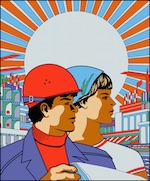 At the 2015 Tucson Festival of Books, I attended a thought-provoking interview with illustrator Bagram Ibatoulline and author-illustrator Eugene Yelchin. The moderator asked them questions about how their experiences as Russian-born artists had influenced their work. Although they alternated their responses in the interview, I have shared their responses separately as individual portraits of each artist.
At the 2015 Tucson Festival of Books, I attended a thought-provoking interview with illustrator Bagram Ibatoulline and author-illustrator Eugene Yelchin. The moderator asked them questions about how their experiences as Russian-born artists had influenced their work. Although they alternated their responses in the interview, I have shared their responses separately as individual portraits of each artist.
Bagram Ibatoulline
 Bagram Ibatoulline was born in Siberia, Russia, in a suburban community. He enjoyed a happy childhood with loving parents who taught at the university; he had nice friends. He showed his artistic talent at an early age. His parents noted that he began sculpting at age three.
Bagram Ibatoulline was born in Siberia, Russia, in a suburban community. He enjoyed a happy childhood with loving parents who taught at the university; he had nice friends. He showed his artistic talent at an early age. His parents noted that he began sculpting at age three.
As a young boy, he “did not care about the Soviet Union.” As he put it, he “walked to school through woods.” However, it was at school that Bagram felt a great deal of pressure from Soviet ideology. Thanks to his artistic ability and the support of his parents, he was sent to art school at age ten and “escaped Soviet influence.”
At the Moscow State Academic Art Institute (MSAAI), Bagram had a classic and rigorous art education. He studied the work of the great masters. Students and teachers alike at the MSAAI were removed from the politics of the day. While there was a great deal of censorship in the Soviet Union at the time, there was also an underground of U.S. music and literature that could be shared among trusted friends. Bagram loved to read Jack London and books about American Indians. He became deeply involved with these stories and visualized these “real” adventures. He noted, “these books made (him) more open to the world.”
Bagram never worked in Russia as artist. He left the Soviet Union at the age of twenty-six and completed his art education in the United States. He said he didn’t see himself being introduced in the Soviet art world and didn’t want to struggle and face the reality outside of the protected world of art education. Bagram believes that Soviet ideology was and remains “on the margins” of his life. He feels he was a “victim of the Soviet Union” because the Soviets “transformed” Russian themes and “spoiled” Russian culture. Rather it is his childhood memories and the emotions he experienced when he was young that are evidenced in his paintings.
Bagram engages in extensive research before painting. He works in a studio with his wife. He plans his activities for the next day but depending on his mood he may spend it mixing colors, searching for images for references, or painting. He listens to audiobooks while he works.
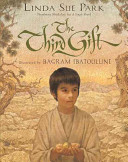 Bagram Ibatoulline paints in watercolor and acrylic gouache and in a variety of styles that reflect the depth of his training. He illustrates books in different genres for children and young adults. His fictional picture books include The Third Gift by Linda Sue Park (Clarion, 2011) and The Matchbook Diary by Paul Fleischman (Candlewick, 2013).
Bagram Ibatoulline paints in watercolor and acrylic gouache and in a variety of styles that reflect the depth of his training. He illustrates books in different genres for children and young adults. His fictional picture books include The Third Gift by Linda Sue Park (Clarion, 2011) and The Matchbook Diary by Paul Fleischman (Candlewick, 2013). 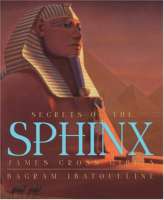 He has illustrated chapter books for children such as The Miraculous Journey of Edward Tulane by Kate DiCamillo (Candlewick, 2006) and Bella at Midnight by Diane Stanley (HarperCollins, 2006) for young adults. His non-fiction and informational books include The Adventures of Marco Polo by Russell Freedman (A.A. Levine, 2006) and Secrets of the Sphinx by James Giblin (Scholastic, 2004).
He has illustrated chapter books for children such as The Miraculous Journey of Edward Tulane by Kate DiCamillo (Candlewick, 2006) and Bella at Midnight by Diane Stanley (HarperCollins, 2006) for young adults. His non-fiction and informational books include The Adventures of Marco Polo by Russell Freedman (A.A. Levine, 2006) and Secrets of the Sphinx by James Giblin (Scholastic, 2004).
Eugene Yelchin
 Eugene Yelchin had a different experience. At this point in time, he has spent half of his life in Russia and half in the U.S. He says that throughout his life in Russia, he engaged in strategies to limit his exposure to Soviet culture. He chose his friends carefully. The U.S. is the place where he can speak openly about the impact Soviet culture has had on his work and his life. (In his author’s note for his novel Arcady’s Goal, he tells a story about how Stalinism continues to affect Russians living in the U.S. today.)
Eugene Yelchin had a different experience. At this point in time, he has spent half of his life in Russia and half in the U.S. He says that throughout his life in Russia, he engaged in strategies to limit his exposure to Soviet culture. He chose his friends carefully. The U.S. is the place where he can speak openly about the impact Soviet culture has had on his work and his life. (In his author’s note for his novel Arcady’s Goal, he tells a story about how Stalinism continues to affect Russians living in the U.S. today.)
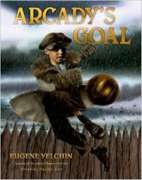 Growing up as an artist in the Soviet Union he was not part of the mainstream. His mother taught in the Russian ballet school. As in all of the arts, the standards for achievement were exceptionally high. Children were taken from their homes at an early age and taught to be very competitive. The result was that “talent was spectacular.”
Growing up as an artist in the Soviet Union he was not part of the mainstream. His mother taught in the Russian ballet school. As in all of the arts, the standards for achievement were exceptionally high. Children were taken from their homes at an early age and taught to be very competitive. The result was that “talent was spectacular.”
He lived in the city of Leningrad (St. Petersburg) and as a young adult worked as a theater designer. He led a “double life;” he was a “citizen by day” and a “dissident by night.” He showed his artwork in friends’ home; the art he created could not be shown in public. As he noted, no one knew who the “informants” were and “who wants to go to prison?” In 1980, he was watching the Olympic Games with his mother. The level of Soviet patriotism was so extreme he “began to look for a hole in the fence.”
In his own writing, Eugene creates a space for young readers where they can see themselves as individuals versus how they function within the collective. His characters develop identities and struggle against conformity. He puts his characters in dramatic situations where they wrestle with these opposing forces. His characters show the courage to be different. He also hopes his novels speak to parents, teachers, and librarians to encourage them to support youth in their individual self-expression.
Eugene studies the work of other artists and writers and noted he is in an on-going dialogue with them. He never knows precisely what influences his art. At the time of the festival, he was re-reading War and Peace. He says he is always “building knowledge.”
He works from 7:00 a.m. until 6:00 p.m. when he stops to make dinner for his family. He mixes the time he spends writing with time spent painting. He just completed his third illustrated novel. He called it a “narrative based on art.” He is considering increasing the visual elements in his novels—something between the “novel and the graphic novel.” He is currently illustrating a picture book that he authored.
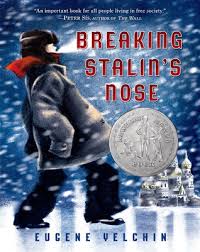 Eugene Yelchin’s first novel Breaking Stalin’s Nose (Henry Holt, 2011) was a Newbery Honor book. He dedicated this book to his father, “who survived the Great Terror.” He opens his second novel, Arcady’s Goal (Henry Holt, 2014), with one of a dozen photographs that “survived the turbulent history of the Soviet Union, the country of my birth.” He illustrated both novels with graphite drawings.
Eugene Yelchin’s first novel Breaking Stalin’s Nose (Henry Holt, 2011) was a Newbery Honor book. He dedicated this book to his father, “who survived the Great Terror.” He opens his second novel, Arcady’s Goal (Henry Holt, 2014), with one of a dozen photographs that “survived the turbulent history of the Soviet Union, the country of my birth.” He illustrated both novels with graphite drawings.
For his picture books, Eugene paints in gouache. His illustrations are known for their child-friendly whimsy and humor. His picture books include The Next Door Bear by Mary Kuryla-Yelchin (Harper, 2011), Seeds, Bees, Butterflies and More! Poems for Two Voices by Carole Gerber (Henry Holt, 2013), and Won Ton and Chopstick: A Cat and Dog Tale Told in Haiku by Lee Wardlaw (Henry Holt, 2015).
This interview with these two notable artists reminded me of the varied ways culture can influence our lives. Our personal circumstances, abilities, and temperaments and our age when external forces impact our thinking and actions matter in terms of how we respond. Thank you to Bagram Ibatoulline and Eugene Yelchin for sharing your life experiences and your work with us at the Tucson Festival of Books and with children, youth, and the world through your books.
Journey through Worlds of Words during our open reading hours: Monday-Friday, 9 a.m. to 5 p.m. and Saturday, 9 a.m. to 1 p.m. To view our complete offerings of WOW Currents, please visit archival stream.
- Themes: bagram ibatoulline, Judi Moreillon
- Descriptors: Books & Resources, Interviews & Profiles, WOW Currents
